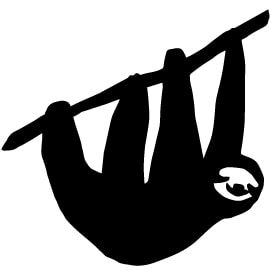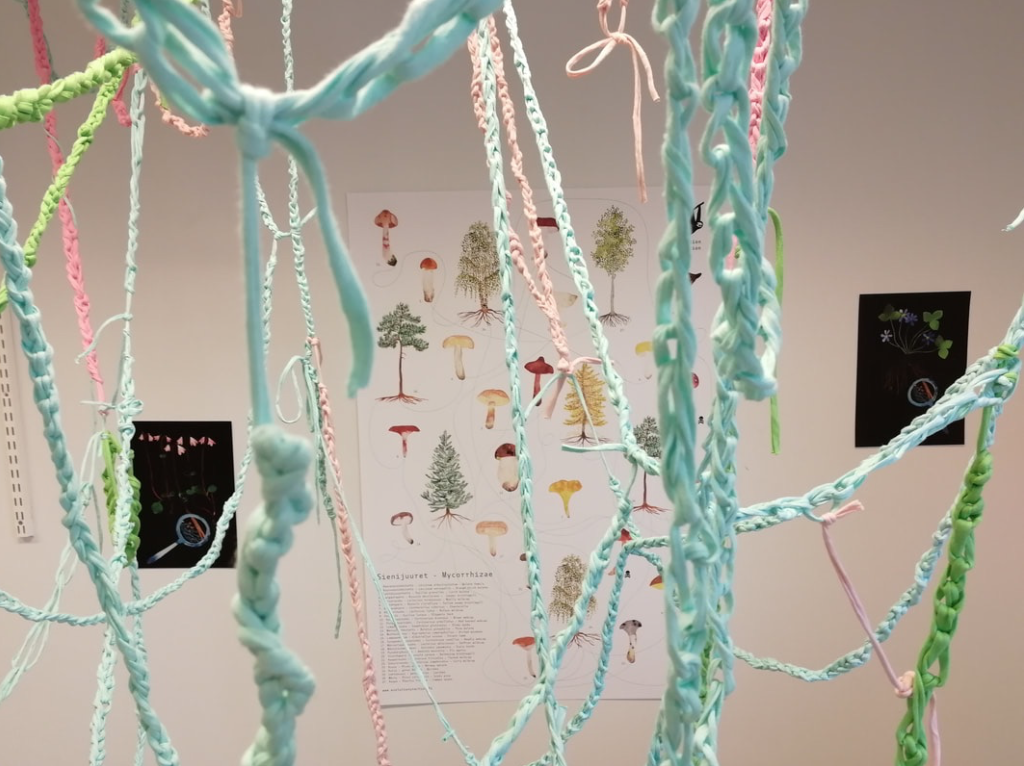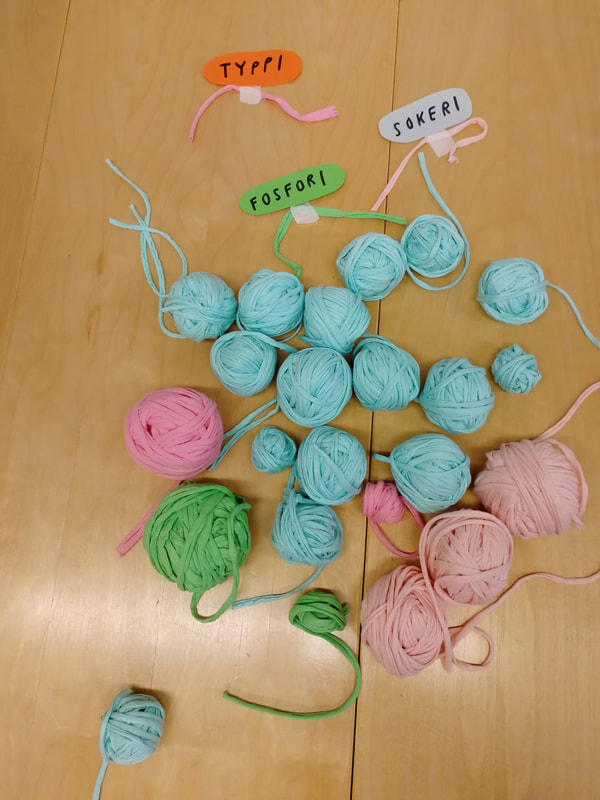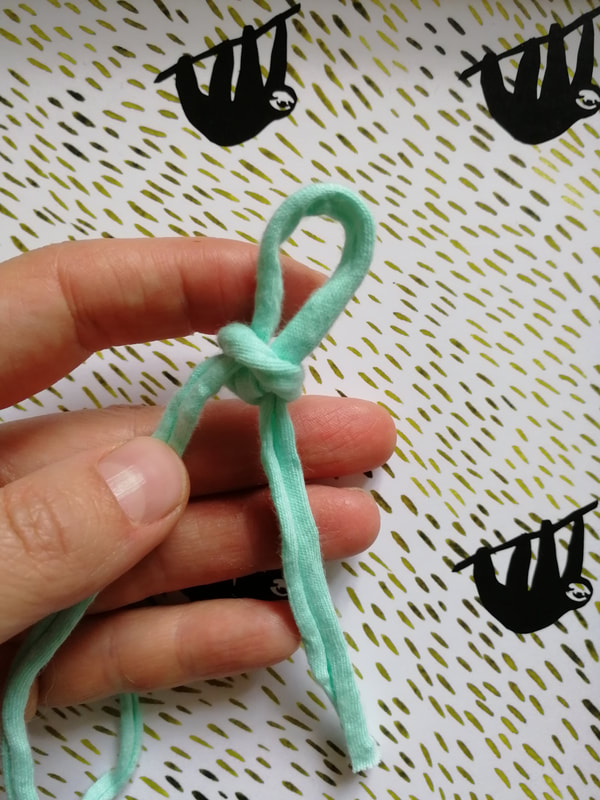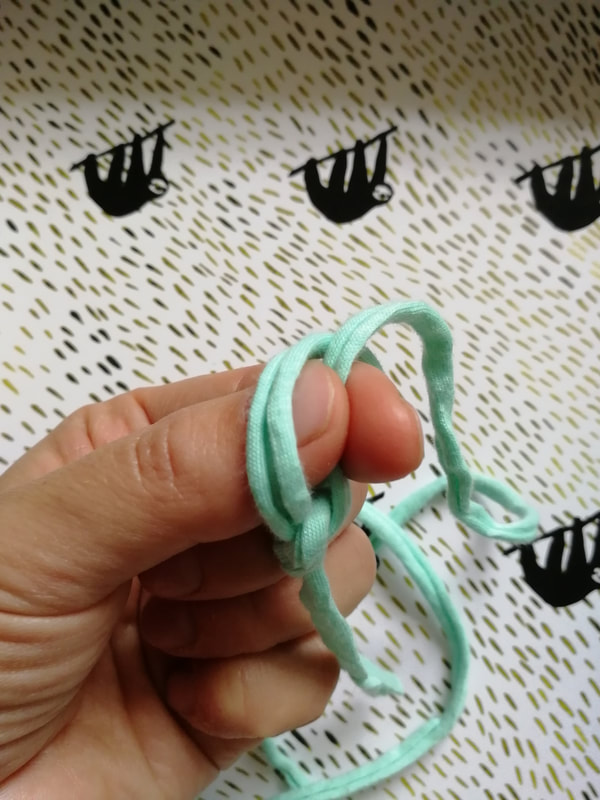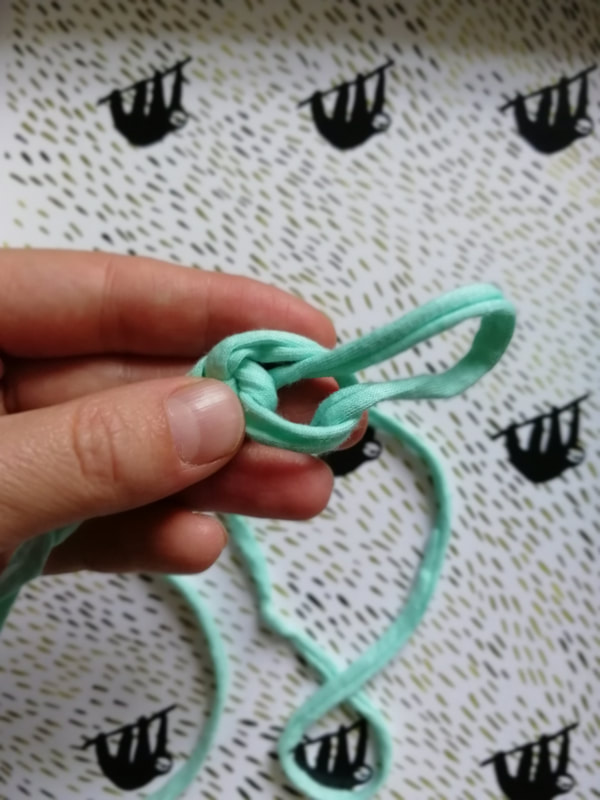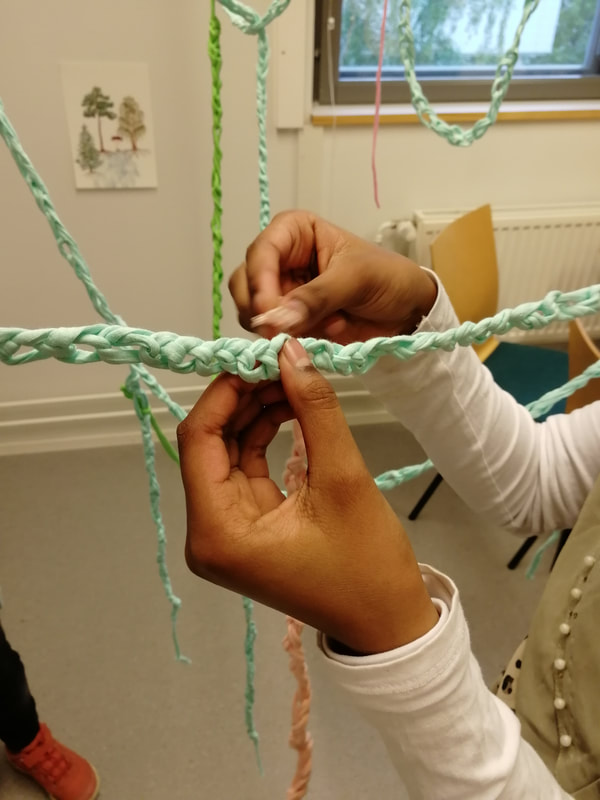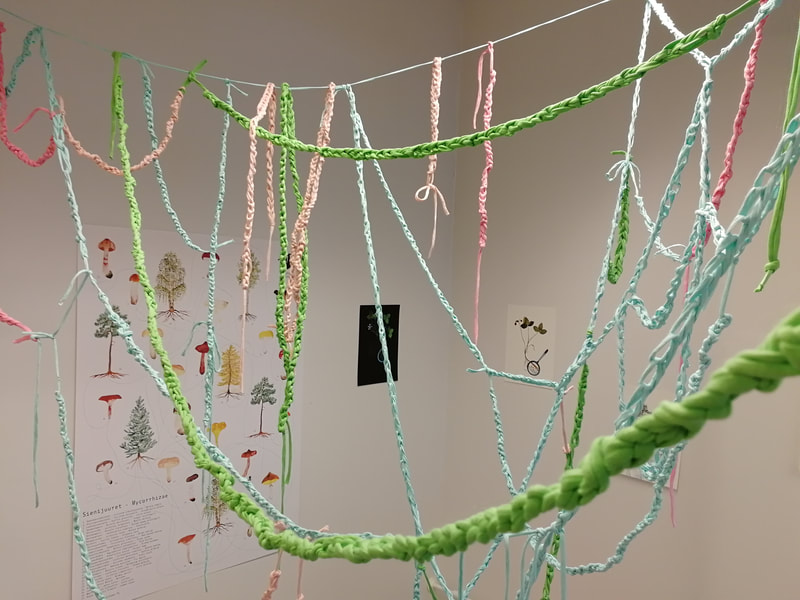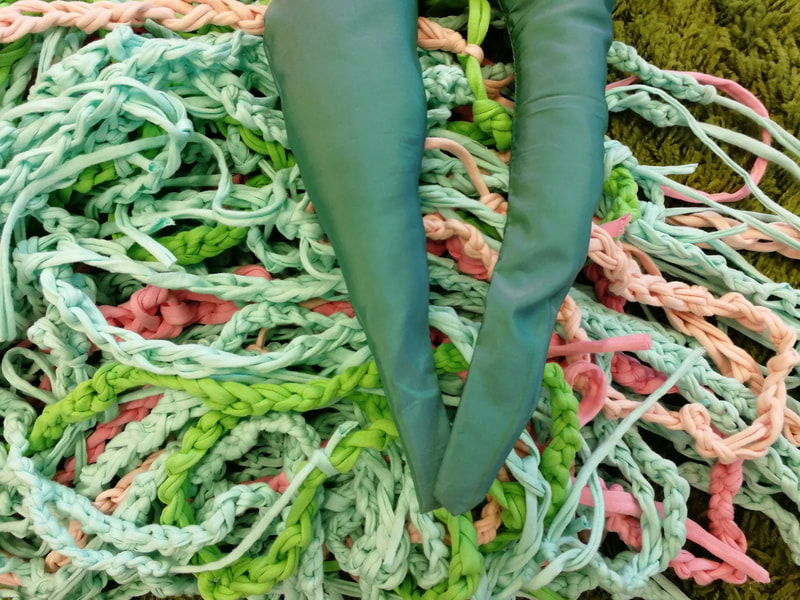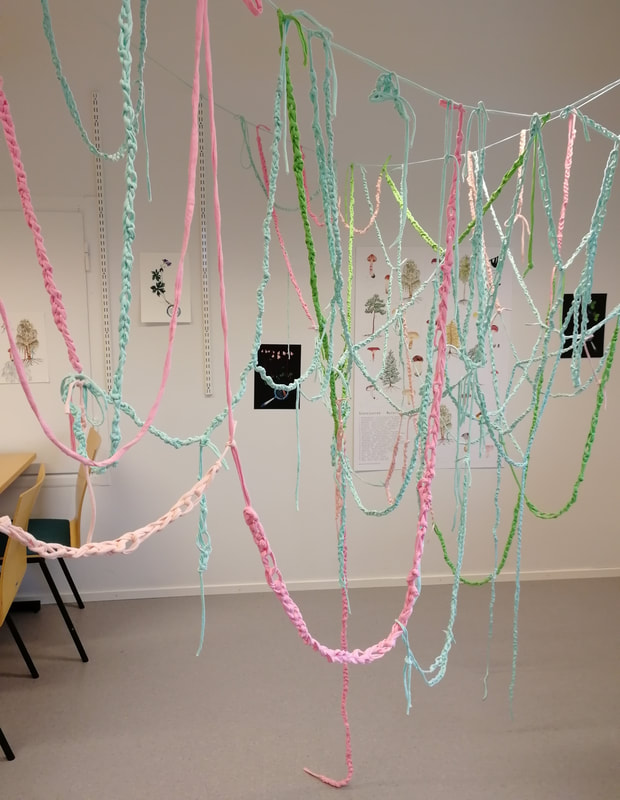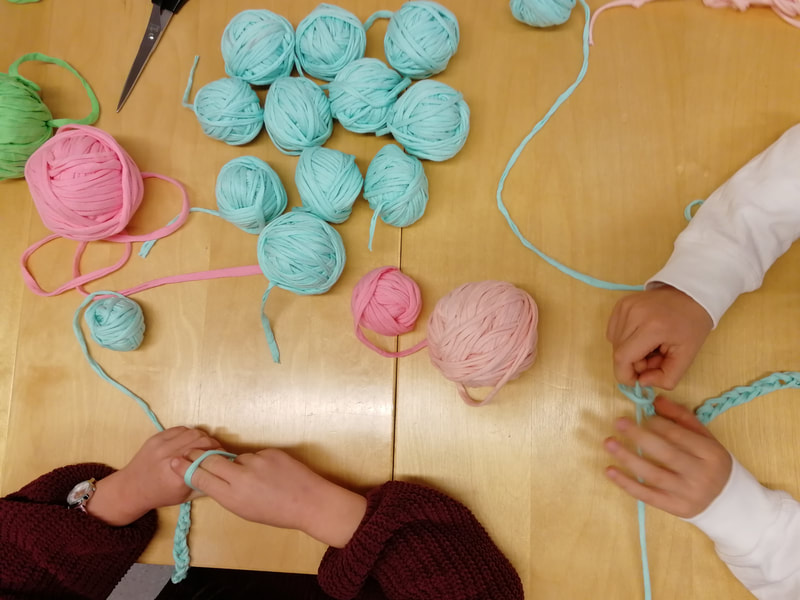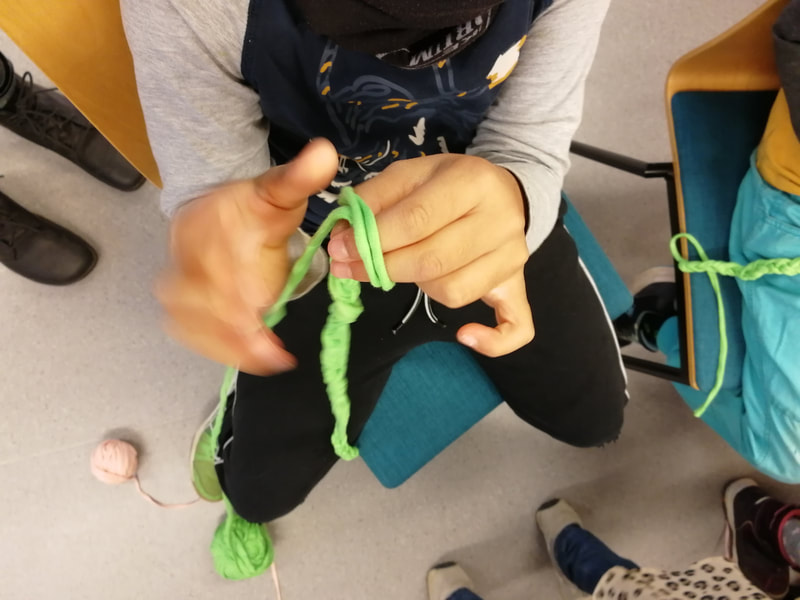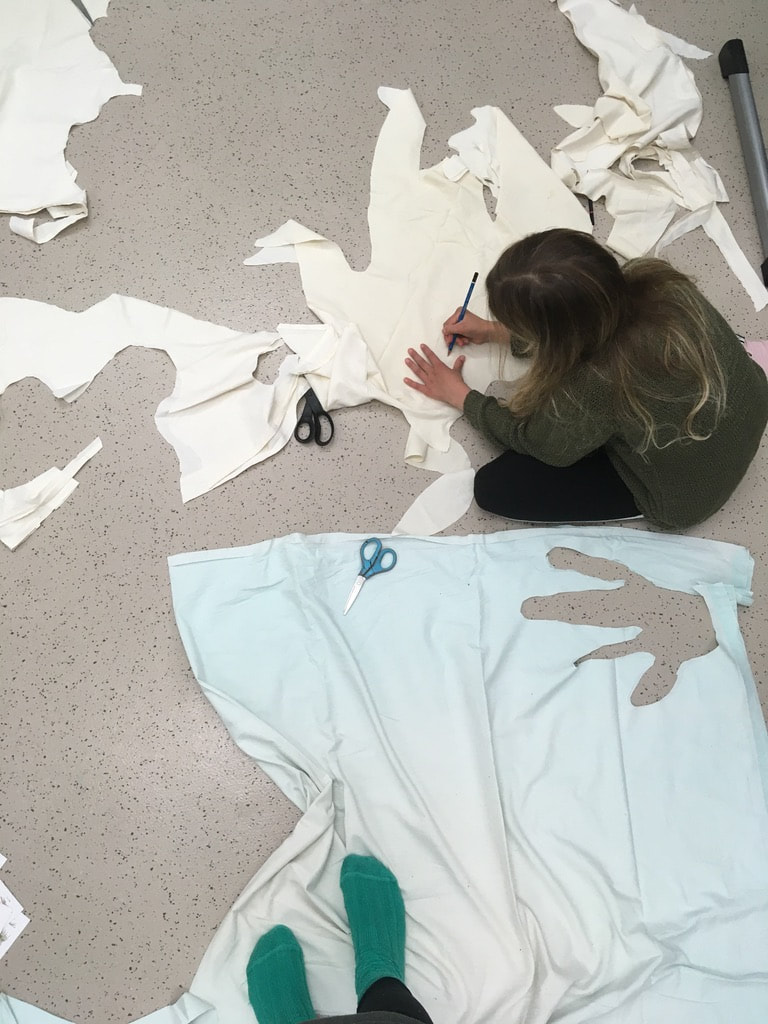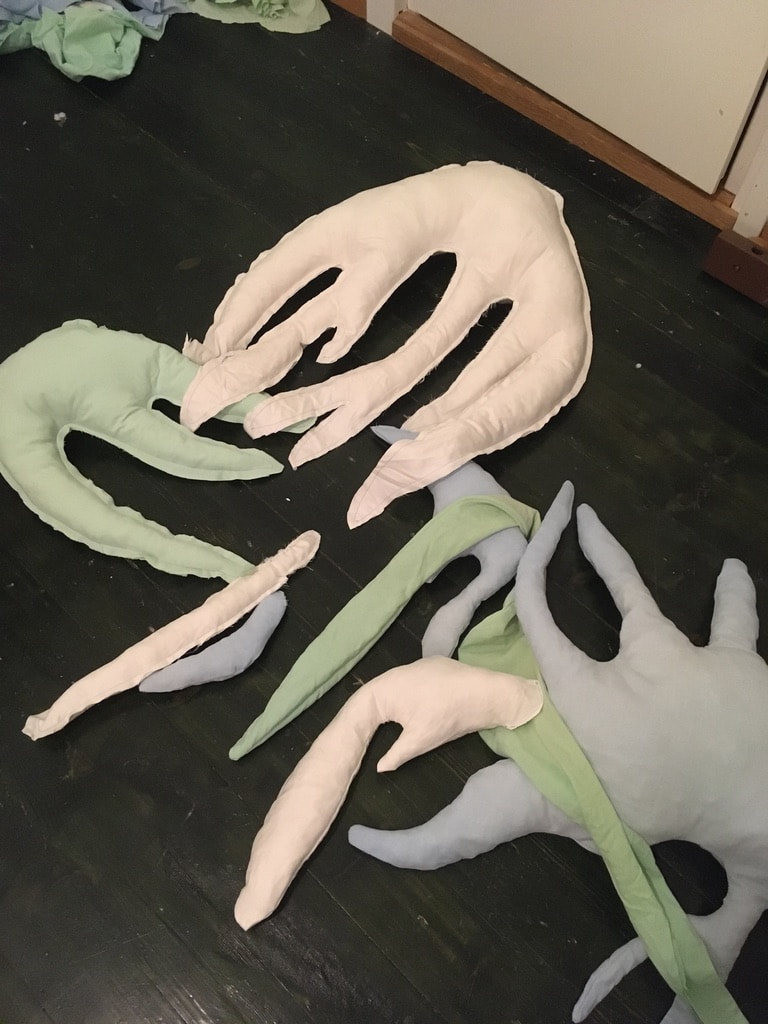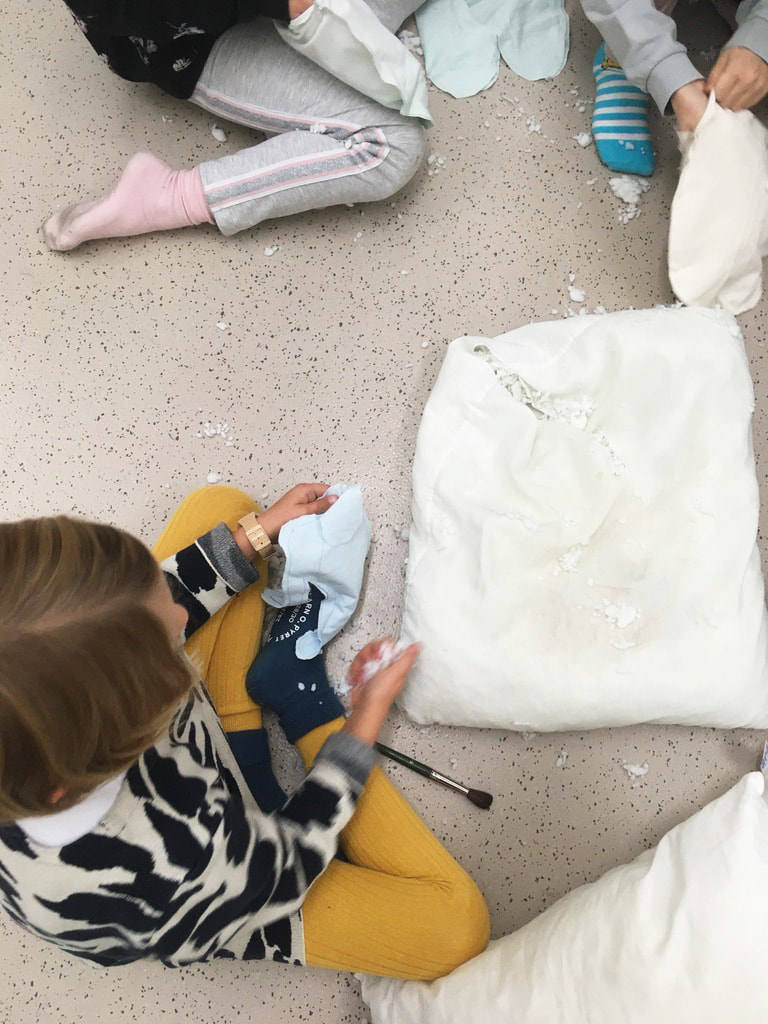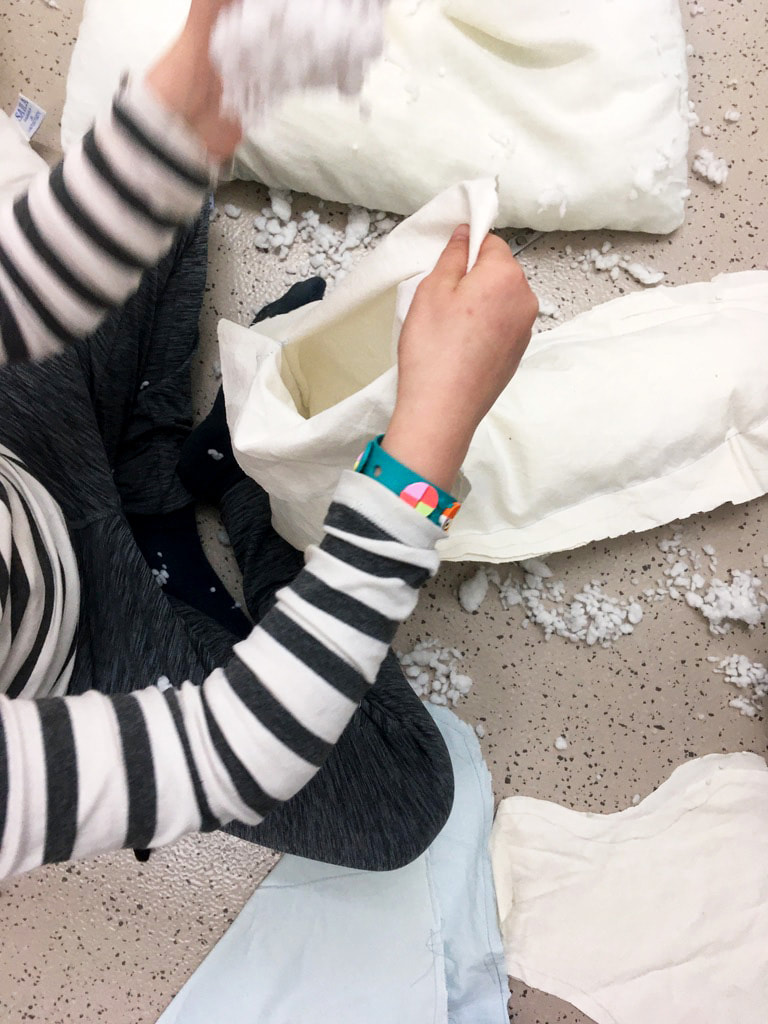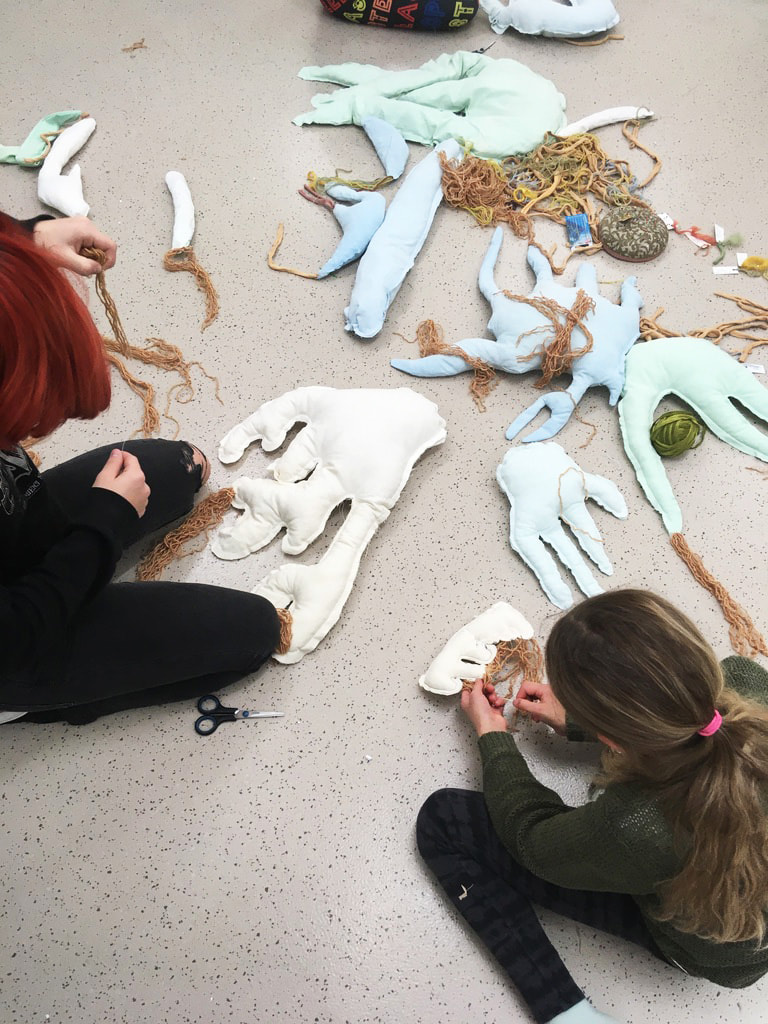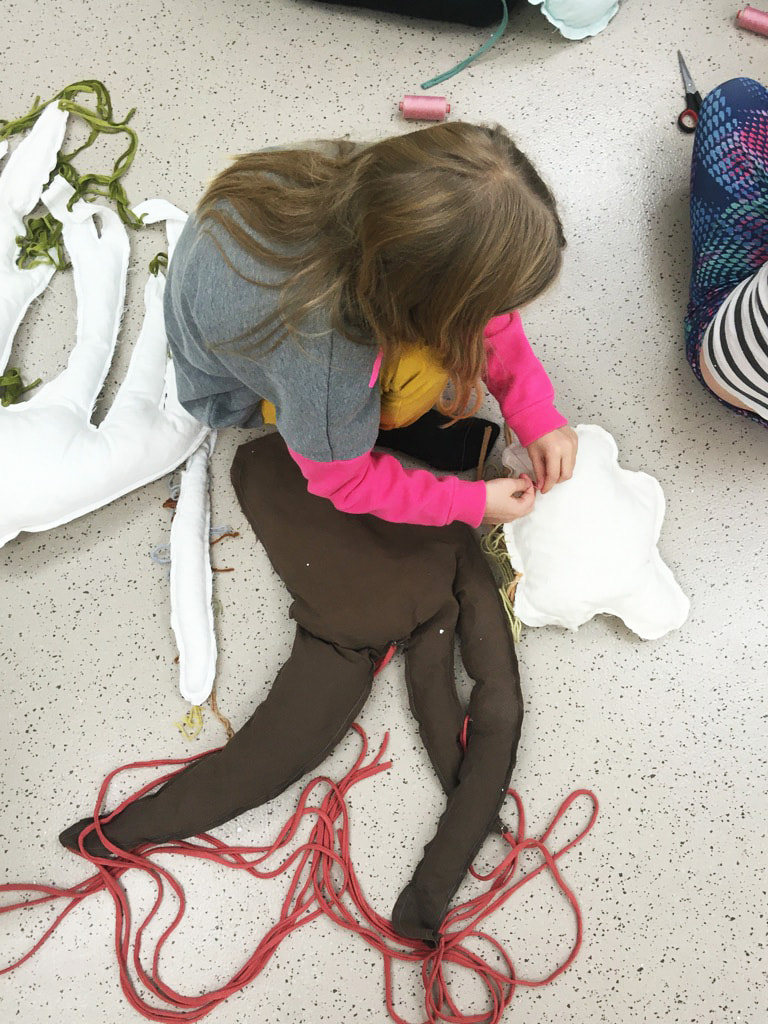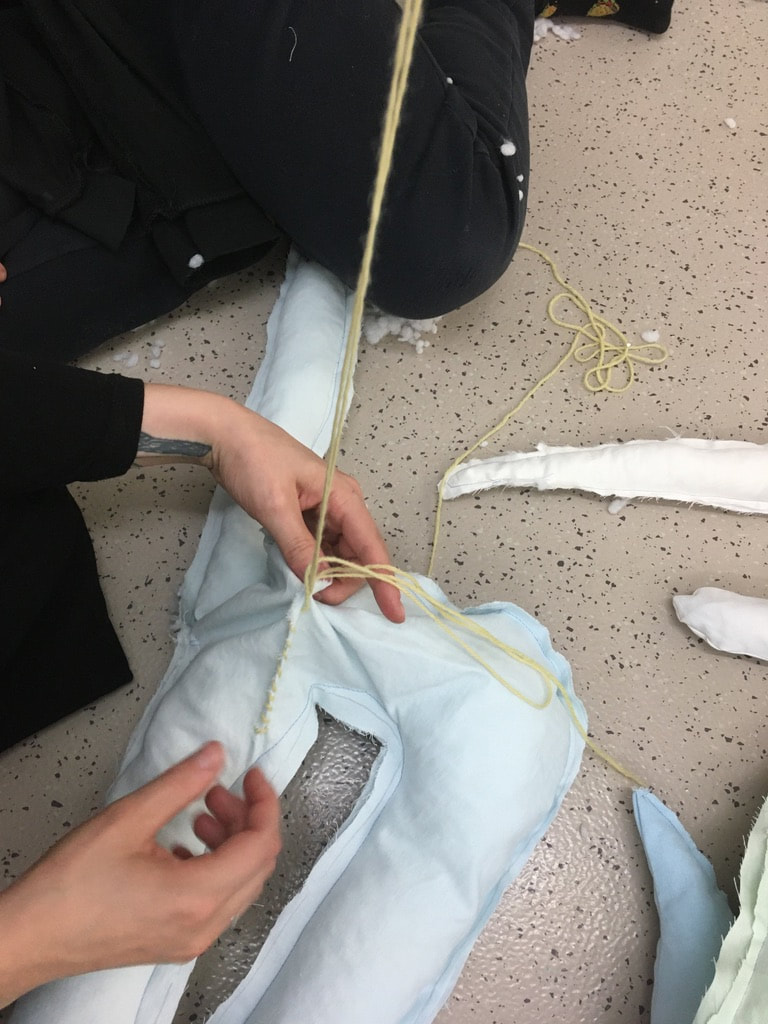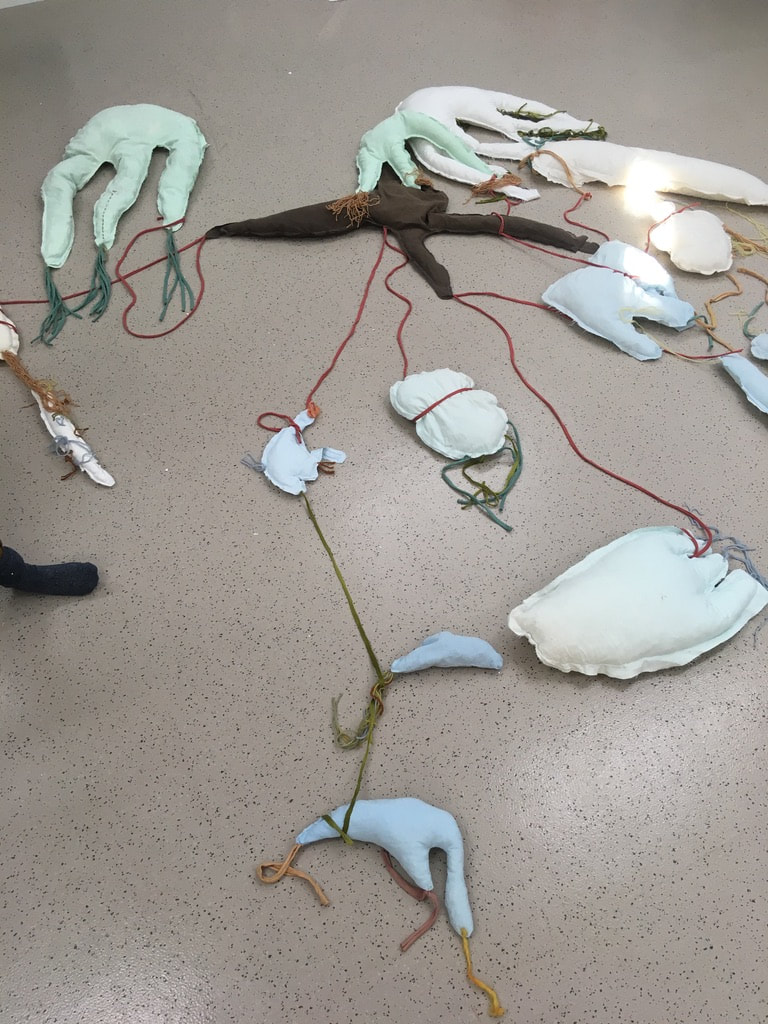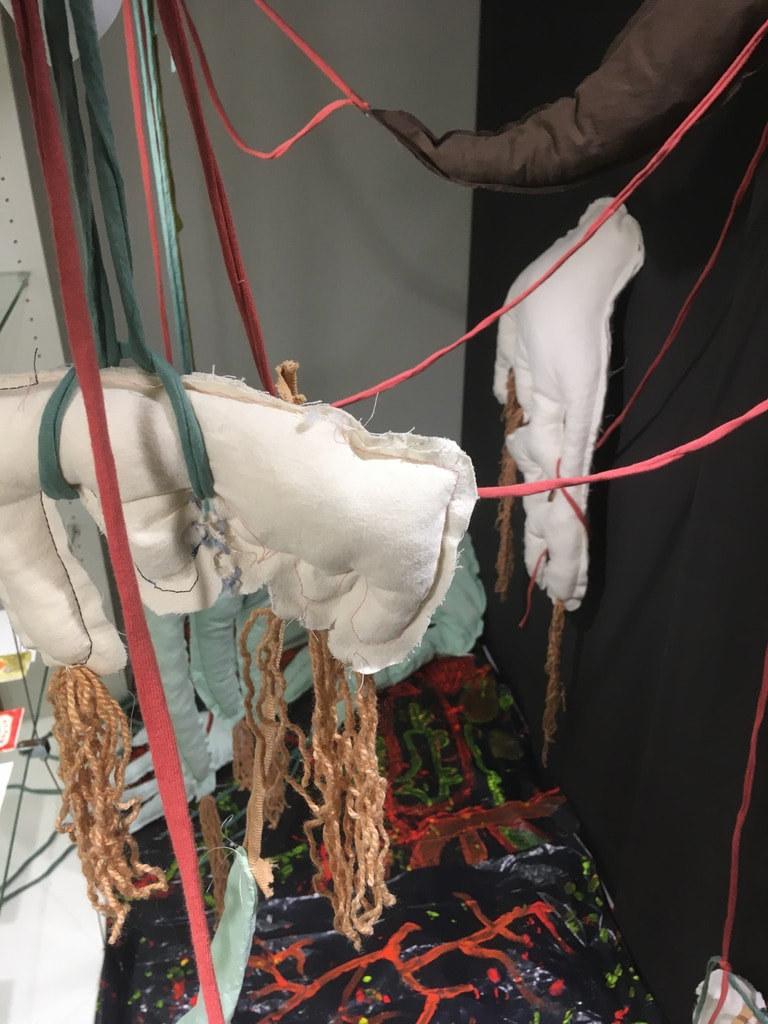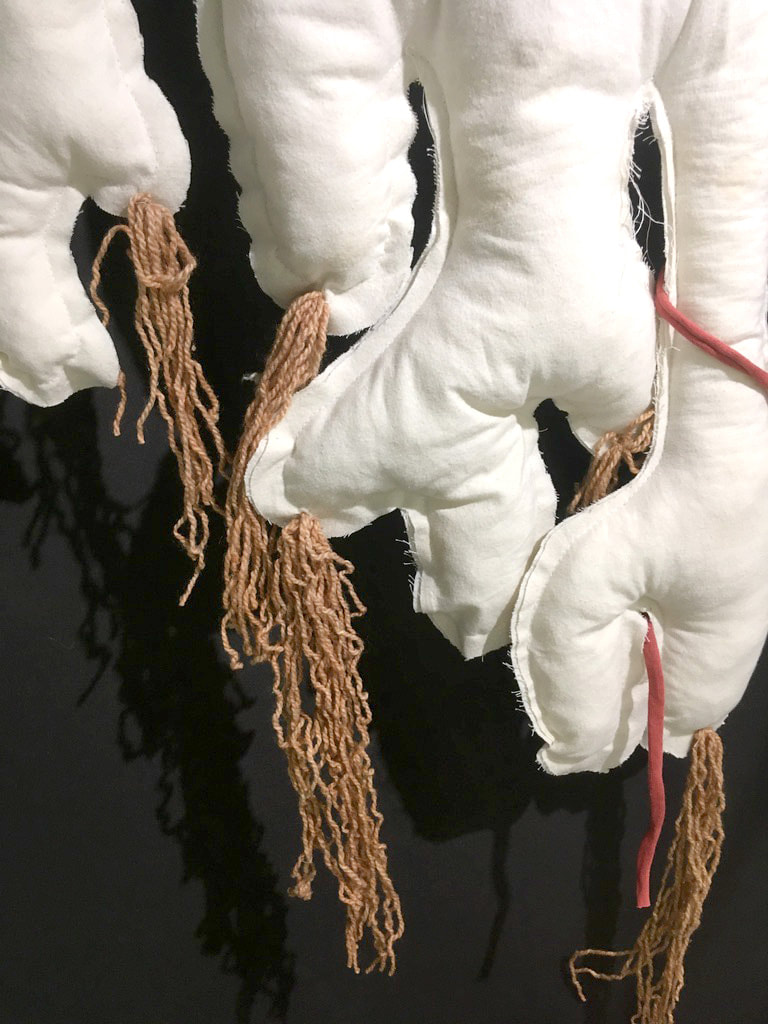Symbiosis
|
2. Knitted mycelia or Mycorrhizal networks
In these exercises we get to know the formation of mycelium and mycorrhizal networks by making a textile art piece together. Based on the time and suitability for the group, you can choose which version of the exercise you would like to use. In exercise a) Knitted mycelia you make colourful, finger knitted fungal mycelia collectively with the group. The steps are simple and this can be done in rather short time (within one school lesson), if wanted. Alternatively in exercise b) Mycorrhizal networks is suitable for deeper work if more time is available. Besides finger-knitting, sewing machine is also used and also a complete mycorrhizal network is formed, when mycelia is combined with tree roots. Introduction: These suit as warmer up before either of the exercises: You can get to know the symbiotic relationship between fungi and plants by listening to our audio track Vascular Plants and Pine (3:20min) or Fungi (2:40min). You can also watch this animation about Mycorrhizae and afterwards talk with participants about interactions happening in the soil (10min) and continue with playing Mystery of the mycorrhizae -memory card game (30min). – – – – – – – – – – a) Knitted mycelia
In this exercise participants make a textile art work, a knitted mycelium* of the fungus, from recycled rug weaving weft. This exercise goes well together with the memory game, where you learn about symbiosis between fungi and trees. In their shared mycorrhizae, trees give sugars to fungi and in return, fungi give trees phosphorus and nitrogen. Mycorrhiza consists of mycelium of the fungus, which is formed by thin hyphae filaments, joined by the tree roots. The symbiotic relationship and cooperation of trees and fungi is the theme for the textile art exercise. Knitting the mycelia offers a chance to play with the spatiality, colours, form and design of the fungal world. The participants will co-create textile art installation, seeing how individual hypha form together tangled web of fungus' mycelia. Age: 7+ Duration: Minimum of 10 minutes /per each knitted piece /per participant, but it depends how long hypha filaments, or big scale work you have the possibility to create. It is possible to make this within one lesson, or have it as continuing process over a longer period of time. You can also divide the group into two, another one playing the memory card game, while others are knitting. Materials:
For installation: A location where it is possible to suspend things from the ceiling, hooks or other structures. You might also want to try installing the knitted mycelia web outdoors, for example between trees.
Instructions: As the main colour of the mycelia, choose the weft which you have the most, the other three then signify nutrients and sugars. You can see, which materials or colours you can access easily, and decide colours based on availability. The intention is to get creative with the materials and not so much to imitate the colours in nature. The most important thing is that making is fun, and offers a moment for creative work together and reflection time for the theme. Each participant chooses a colour they wish to knit, and makes a piece of hypha, nutrient or sugar of their desired length by finger knitting. You may want to make little balls of weft (or yarn) ready for this, or then make ready cut pieces of it. For the collective web to form, first hang some lines on the ceiling (or tree branches outdoors) where participants can then attach their knitted pieces. Once there are more of them, you can start to attach pieces to one another, so that a tangled web is formed, hypha by hypha. – – – – – – – – – – Finger-knitting is simple: |
|
1. Make a loop to the weft yarn. 2. Place your thumb and index finger through the yarn, and catch the longer tail of the yarn between your fingers. 3. Thread the yarn through the loop. Thus a new loop is formed. Place your thumb and index finger through the loop again and thread the yarn through. 4. Repeat this, until you reach the desired length. To finish: cut the yarn and thread the end through the last loop, pull it tight. – – – – – – – – – – |
|
|
|
– – – – – – – – – –
b) Mycorrhizal networks In the previous exercise participants have learnt how the mycelium is formed. In this exercise we explore what happens when mycelium web connects with roots of plants. We will work in a group with textile materials and we will weave mycorrhizae. By creating spatial installation participants will learn about collaboration and symbiotic processes between fungi and trees. In their shared mycorrhizae, plants give sugars to fungi and in return, fungi supply the plants with phosphorus and nitrogen. Participants will get to imagine and understand how the nutrients and sugars are exchanged between plants and fungi through mycorrhizal network. Age: 8+ Duration: 3 x 45min Materials: Old sheets in at least 2 different colours, rug weaving weft, or other thick yarn, at least 2 different colours, sewing machine, scissors, sewing needles and thread, pillow filling (can be also fabric cut into small pieces). First part (35-45 min): 1. Fold fabric sheets or other recycled textile, place fabric in two layers on the table. 2. One third of the group can start to sketch and draw the shape of the tree roots on fabric. It helps if the fabric for tree roots have a different colour from fungi. 3. Rest of the group will design and draw shapes of fungal hyphae on different colour fabric. 4. Now you can cut shapes you designed, and sew both sides together on a sewing machine to either ‘hyphae’ or ‘tree root’ pillows”. Remember to leave a small hole in the size of your hand. 5. Fill the hyphae shape pillows and tree root shape pillows. Stitch in the hole. Second part (45min): 1. We recommend you to look at first exercise a) Knitted mycelia, where you can see instructions for finger knitting and working with rug weaving weft. 2. Those who made tree roots can start to finger-knit in one colour (symbolising sugar) and attach the knitted pieces to the pillows. The knitted pieces can be various lengths and sizes. Everyone who made hyphae pillows can now attach weaving weft or other thick yarn to their pillows in similar manner, but using different colours in knitting (symbolising nutrients). 3. The participants can now start to co-create installation, seeing how individual hyphae form together tangled webs of fungus' mycelia. Choose a location where it is possible to suspend things from the ceiling, hooks or other structures. Start to attach knitted pieces to one another, so that a tangled web is formed, like in exercise a). Connect fungus' mycelia together with tree roots. Together they form a mycorrhizae, which enables the exchange of nutrients and sugar between the tree and fungus. |
|
|
|
Tips:
|
|
– – – – – – – – – –
Our materials are licensed under the Creative Commons Attribution-ShareAlike 4.0 International License: http://creativecommons.org/licenses/by-sa/4.0/. It means you can use our materials freely, but please remember to always credit our work and mention us whenever you are sharing contents of our project online: Instagram: @evolution_in_action, Facebook: @evoluutiopajat, Twitter: @EvoWorkshops. If you use our materials in teaching, we are happy to hear greetings and feedback. You can tag us on social media or send us an email: [email protected] Evolution in Action logo: jpeg, eps |
